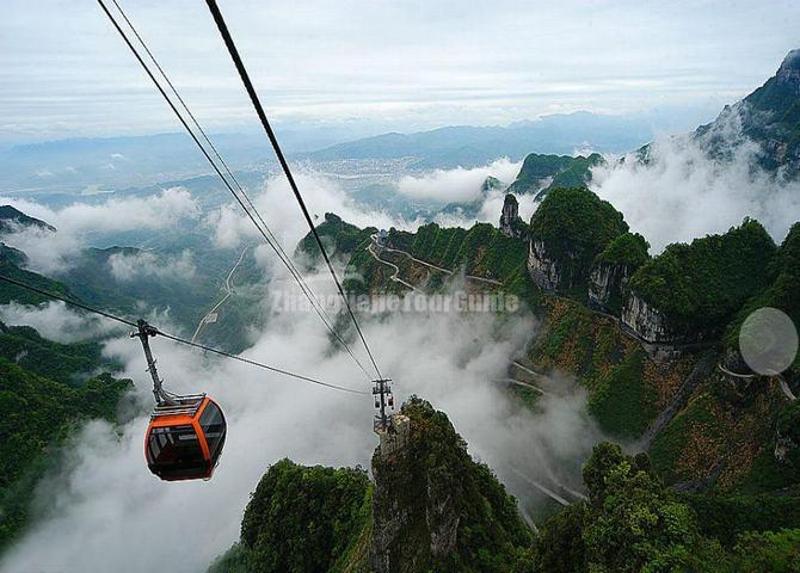
The Geology of Tianmen Mountain
Tianmen Mountain, located in Zhangjiajie National Forest Park, China, is a majestic peak renowned for its breathtaking scenery and unique geological formations. The mountain showcases a fascinating blend of geological processes that have sculpted its distinctive features over millions of years.
Geological Structure
Tianmen Mountain is an integrated synclinal geological unit characterized by a middle-mountain karst platform adorned with peak groups and deep canyons. This means that the mountain is essentially a large, bowl-shaped fold in layers of rock that have been uplifted over time.
Karst Landforms
The mountain's geology is dominated by karst formations, a result of the dissolution of soluble rocks like limestone. Let's delve deeper into the key karst features:
Karst Platform
The top of Tianmen Mountain forms a vast karst platform. This plateau-like structure results from prolonged erosion and dissolution of the limestone bedrock. The surface of the platform is often characterized by:
- Karst depressions: These are closed depressions in the landscape formed by the dissolution of the underlying rock.
- Sinkholes: Similar to depressions but typically steeper and deeper, often forming dramatically when underground cavities collapse.
- Karst springs: Locations where underground water emerges onto the surface, often contributing to the formation of caves and other karst features.
Peak Groups and Canyons
The forces of erosion have carved dramatic peak groups and canyons into the karst platform:
- Peak Groups: These towering peaks, remnants of the more resistant portions of limestone, stand as sentinels across the landscape.
- Canyons: Deep, narrow valleys with steep sides, formed by the erosive power of rivers and streams cutting through the soluble rock.
Stone Forests
One of the most striking features of Tianmen Mountain is the presence of stone forests, particularly on the summit plateau:
- Karst Hillocks: These are cone-shaped hills, often densely clustered, formed by the differential weathering of limestone.
- Karrens: These are grooves and channels etched into the rock surface by the dissolving action of rainwater.
| Feature | Description | Formation Process |
|---|---|---|
| Karst Platform | Flat, elevated landform | Dissolution of soluble rock, erosion |
| Peak Groups | Towering rock formations | Differential erosion, resistant limestone remnants |
| Canyons | Deep, narrow valleys | Erosion by rivers and streams |
| Stone Forests | Collections of karst hillocks and karrens | Differential weathering, dissolution of limestone |
Formation Over Time
The spectacular landscape of Tianmen Mountain is the result of a long and complex geological history:
- Deposition of Limestone: Millions of years ago, the area was submerged under a shallow sea where massive deposits of limestone accumulated.
- Tectonic Uplift: The collision of tectonic plates caused the uplift of the region, lifting the limestone layers above sea level.
- Karst Processes: Over time, rainfall, combined with carbon dioxide from the atmosphere, created slightly acidic water that dissolved the limestone. This process, known as karstification, carved out the caves, depressions, canyons, and other characteristic features.
- Erosion and Weathering: Physical weathering processes, such as freeze-thaw cycles, and erosion by wind and water, further shaped the landscape, creating the dramatic peaks, cliffs, and stone forests we see today.
FAQs
What type of rock primarily makes up Tianmen Mountain?
Tianmen Mountain is primarily composed of limestone, a sedimentary rock that is highly susceptible to dissolution, leading to the formation of karst landscapes.
How did the canyons on Tianmen Mountain form?
The canyons were formed by the erosive power of rivers and streams cutting down through the soluble limestone over millions of years. This process, combined with tectonic uplift, resulted in the deep, narrow valleys that characterize the mountain.
Why are there so many peaks on Tianmen Mountain?
The numerous peaks on Tianmen Mountain are remnants of more resistant layers of limestone. As erosion and dissolution sculpted the landscape, these harder sections were left standing, creating the iconic peak clusters.